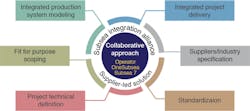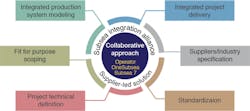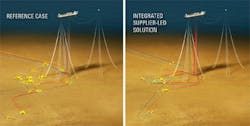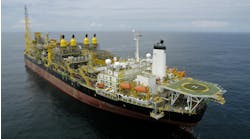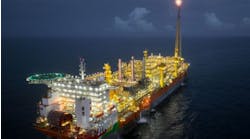Approach enables design simplification, interface streamlining
Florent Hurault de Ligny,Subsea 7
Ian Roberts, David James, and Ekaterina Eliseeva, Schlumberger OneSubsea
Inthe industry’squest to maintain profitable oil and gas developments, adopting an integrated supplier-led solution (SLS) is becoming a key component. It introduces opportunities to provide a more open approach to the design and engineering process and more access to information about the reservoir. Adopting an integrated SLS approach also enables comparison of various concepts and optimizations not only in terms of cost, but also the production and hence, revenue a concept will deliver. In so doing, it goes a long way in avoiding the pitfalls of reducing cost at the expense of inadvertently reducing revenue. Cost savings are a focus; however, opportunities to increase or accelerate production are equally emphasized.
The industry has triggered many consolidations and moves among operating companies, contractors, and suppliers. Several consolidations have taken place over the past three years motivated by a willingness to address cost challenges and capitalize on opportunities for added value through the synergies offered by two companies coming together. An example of these consolidations is a subsea production system (SPS) supplier and a subsea umbilicals, risers, and flowlines (SURF) contractor, forming an integrated subsea alliance.
An integrated supplier-led solution is when suppliers or contractors take the lead on the definition and execution of a project.
A case study highlighted later in this article demonstrates how, the combination of OneSubsea’s SPS and Subsea 7’s SURF expertise in one such alliance, Subsea Integration Alliance, can deliver value through fully integrated early engagement. The methodology applied was flexible and can be customized for any offshore prospect. Beneficial outcomes from the case study included:
• Accelerated production resulting from the introduction of subsea boosting technology and demonstrated via integrated modeling
• Significant reduction in capex
• Accelerated schedule due to a proposed innovative bidding process and a reduced equipment lead time enabled by standardization
• Lower project risk profile by improving the execution predictability primarily due to the integrated subsea offering.
Integrated SLS
Essentially, an integrated SLS is when suppliers or contractors take the lead to define and execute a project, as opposed to a traditional approach whereby suppliers bid on a well-defined solution and must comply with a long list of specifications. An integrated SLS enables a supplier to propose its best solution for a given development. This solution, unlike conventional project execution models, is partially or totally unconstrained by the operating company. The operator role is to provide the inputs needed by the supplier to be able to determine a solution, and to explain project drivers. Of course, the supplier needs to have the skills and the experience to be able to develop a viable solution.
A successful integrated SLS is based on six building blocks as shown in the first figure and described below.
Fit-for-purpose scoping.The first building block addresses the way the project is specified by the client. The inputs expected at this stage are limited to the key functional requirements, with a focus on what needs to be achieved rather than how. The drivers that will make the project successful also need to be clearly specified. This represents an important evolution in ways of working. The philosophy around the project definition and design scoping is based on a totally different mindset compared to the traditional approach. Instead of providing detailed and constrained specifications with predefined design to the contractors, the operating company will provide the minimum required inputs.
This fit-for-purpose approach enables contractors to propose their best solutions based on capabilities and experience. The requirements are not generic, but rather weighted against the project needs with a flexible, collaborative approach. This fosters reusability of existing designs which will not only generate cost savings and schedule predictability, but also improve safety and quality through repeatability and continuous improvement.
The schematic on the left illustrates the reference case provided by the operating company, which was a conventional, robust, but rather costly field architecture. The schematic on the right illustrates the SLS which has a more simplified architecture comprising single flexible flowlines instead of loops, elimination of gas lift, and optimization of the water injection system.
Integrated production system modeling. Each working solution is assessed and quantified with an integrated production system modeling. This is achieved by coupling reservoir, wellbore, network, and facility models through direct integration so that the full integrated model is solved at every time step in every point of the system. Running an integrated model gives dynamic accurate hydraulic response to changing conditions across the production system from the source rock to the facility. It enables the quick and efficient evaluation of multiple concepts, including reservoir responses and flow assurance aspects.
Many potential field development options can be explored at the earliest project phases without having to separate the models, manually change the output forecast, or reduce the complexity of the system and its components. Flow assurance and other production issues can be identified and addressed early, and systems can be properly sized to maximize the return on investment.
The flowchart shows the process to develop the integrated supplier-led solution which is collaborative in nature with inputs from both operating company and supplier.
Project technical definition. The next building block is about how to come up with the most efficient technical solution for the project. The mindset here is to look for a globally optimized solution by using fit-for-purpose equipment that best meets the overall field architecture criteria. New technology can be introduced if it has a positive impact on the overall economics of the development.
Early engineering has traditionally been performed by operators or with the support of engineering firms. The recent downturn has forced the industry to try different models; contractors and equipment suppliers’ roles have grown in these early phases and they have been given a chance to show what value they can bring. An integrated SLS is probably the most efficient way to ensure that suppliers will be able to propose their best solution. An integrated SLS shapes an approach that is unique and tailor-made to those who will execute it; the objective is to maximize the value of the development for the operating company.
There are multiple benefits in having the suppliers involved in the project definition, and in particular, on the subsea part. These benefits are even more important when the subsea part is integrated.
Standardization. The use of standard equipment building blocks reduces the engineering required for a project solution and will contribute to reduce costs. For example, the use of contractor standards for multiple operators enables common stocking programs and economy of scale in the manufacture of components and subassemblies. A key aspect of standardization is to have material, welding, and quality specifications and processes that are acceptable to the industry and not operator specific. This allows products and systems to be built from a common catalog of parts to yield a project-specific solution.
Standardization of equipment can make a significant contribution to the overall economics of the field development by reducing equipment cost, shortening the project duration to first oil, and reducing risk.
Standard equipment has the following attributes:
• Standard material, quality, welding, and paint specifications
• Approved standard designs, including functional design specification
• Qualified components
• Released subassembly bill of materials
• Approved vendor list
• Available in contractor’s internal standards catalog.
Suppliers and industry specification. The next building block is the adoption of suppliers or industry specifications rather than operator specifications, which are often more stringent. International industry recognized standards, such as API, NORSOK, or DNV, will provide the basis for safe and efficient design. Also, there is value in leveraging the experience acquired by suppliers over the years for various clients in various locations.
Meeting the standardization goal of standard components and subassemblies that are manufactured, either for stock or available from ongoing production, as needed to meet accelerated delivery schedules is essential for one set of specifications to be used consistently within the manufacturing process to allow items to be assigned to any customer at the time of final assembly and equipment testing.
Contractor’s standards should as a minimum meet the published industry standards applicable to metallurgy, welding, and quality.
Integrated project delivery. Finally, the integrated project delivery concept provides some additional benefits and cost savings during the project execution. The integration of the subsea equipment and installation scope opens the door to seamless interface management, resulting in more efficient engineering and reduced risk profile. Project predictability is consequently improved, reducing the risk of cost and schedule overrun. The absence of stringent specifications and requirements allow using lean project management structures, both for the contractors and the operator, resulting in further cost savings.
Essentially an integrated SLS will allow a reduction in execution costs and risks associated to the project, as detailed below. This is achieved by a combination of novel ways of working and project team setup. Some examples of these features are:
• Integrated reservoir and production system engineering and design verification
• Direct SPS-SURF interface management
• Integrated schedule and convergence plan
• Integrated testing program.
Cost reduction is enabled by a streamlined project management organization and efficiencies generated by the integration.
Case study
The case study concerns a large, complex deepwater development in a remote location. The field had been discovered more than a decade ago but, after multiple attempts, an economically viable development concept had yet to be found. The operating company proposed a challenge: the latest development concept (reference case) was provided and Subsea Integration Alliance was invited to propose an SLS, totally unconstrained, to improve the project economics and hopefully allow it to pass the next decision gate.
The process of this challenge was divided in two main parts: providing a budget pricing and a high-level schedule for the reference case, and providing an alternate integrated SLS, based on a minimalist functional specification. The integrated SLS could be based on alternative field architecture, new technologies, strategic partnerships, supplier internal protocols, supplier-selected equipment and methods, etc. This solution was fully unconstrained so that the integrated subsea alliance could propose its best solution from its own perspective.
The field is divided into three main production areas: north, central, and south. Each location has a number of production and water injection wells. The production is flowed back to an FPSO, where the oil is processed and exported via an offloading buoy system. The gas is exported in a dedicated gas export line. Production wells are split in two categories: high-pressure wells and low-pressure wells. High-pressure wells and low-pressure wells cannot be commingled.
Reference case
The reference case provided by the operating company was a conventional, robust, and rather costly field architecture. A number of production and water injection wells were tied back to the FPSO, where the oil was exported via an offloading buoy, and the gas was transported through a long gas export line. Production trees were connected to the FPSO via conventional pipe-in-pipe flowline loops and steel catenary riser (SCR), using dead oil circulation as a preservation strategy. Rigid jumpers were used to connect trees to manifolds or pipeline end terminations (PLETs).
SLS case
The main changes from the reference case are:
• The production loops have been replaced by single line systems. This has been made possible thanks to a heated flexible risers and flowlines solution. This technology enabled the single line configuration in which hydrates are managed by heating instead of dead oil circulation. This resulted in significant reduction of hardware, and hence, cost. On all these single lines either low- or high-pressure wells (not both), have been connected and comingled except on the North drill center. Here, a boosting pump has been added with the objective to remove one flowline. The boosting pump is used to match the pressure of the low-pressure wells to the same level as the high-pressure wells and enhance production.
• The gas lift functionality has been removed, eliminating an important part of the cost. The impact on the production of such a change has been carefully assessed.
• All-electric water injection trees have been proposed, allowing significant simplification of the umbilicals cross section by removing all the hydraulic lines.
• The water injection network has been reviewed and optimized, so the overall risers and flowlines length has decreased. The tradeoff for this was the use of slightly higher diameter risers and flowlines, and a more complex riser design (with a double lazy-wave configuration).
• The control system has also been completely reviewed to again reduce the overall length of products, by using more complex but perfectly feasible umbilicals cross sections. For instance, the MPP power cable has been combined with the E/H umbilical.
• A special connector has been proposed on certain production and water injection trees to provide an efficient daisy chain method, removing the need for multiple structures and jumpers. This method had some consequences on the installation feasibility, but the integrated team was able to quickly demonstrate the feasibility and price the impact.
• Finally, the project has been turned into a full flexible flowline project: in the integrated SLS there is no more rigid pipeline, avoiding the mobilization of a pipelay asset.
Integrated SLS improvements
To develop the integrated SLS, the team started from a blank page and went through an extensive concept screening exercise to identify the best solution. An integrated multi-discipline team was able to quickly evaluate each concept that was generated against multiple criteria: cost, technical feasibility, risk, schedule, opex, operability, and production recovery.
Using SLS methodology led to significant improvements of the project performance profile. This can be summarized in four main categories: capex reduction, improved predictability, optimized recovery, and schedule acceleration. The capex on this project was the main driver as only a significantly lower cost could allow the project to be sanctioned. An overall reduction of 41% was achieved. In addition to these direct cost savings, the internal costs for the operating company are also reduced by a reduction in contingencies.
The subsea integration approach presents improved predictability in terms of both cost and schedule due to, among other things, seamless interface management and risk transfer and mitigation. The overall risk profile of the project is reduced.
The evaluation demonstrates that the SLS not only reduces equipment cost/capex, but also extends the oil production plateau. This improves overall project economics by accelerating production because early cash flows are discounted less. As an example, the total production increase in the first five years was estimated to be 17%.
Project schedule was also significantly improved. There are two parts to this improvement. The first one is the overall process of a project relying upon an integrated SLS. Several models can be used, the fastest one being a sole-source engagement from the very early stages. Another common model is a design competition between typically two integrated subsea contractors. All these models have one thing in common—they allow accelerating the pre-award phase compared to a traditional process.
The other part of schedule acceleration is the actual execution duration. Because industry specifications and standard products are used, great efficiency is gained for design and procurement phases. Long lead items lead time is drastically reduced and can even be kicked off during the front-end engineering design phase once sufficient definition has been achieved.
Conclusion
Profound changes proposed in the integrated SLS led to significant cost reduction compared to the reference case, due to the reduced hardware and the introduction of novel technology. In addition, the use of standard equipment, supplier’s specifications, and opportunities linked to the integrated project execution also permitted cost reduction. For example, a total delta of 41% cost reduction and an early life production increase of 17% between the reference case and the supplier-led solution were achieved in the current case study, which on this type of large development could be a game changer for project viability and economic performance. Also, schedule acceleration can result in an overall schedule reduction of more than 10 months from a 40-month project duration for the traditional reference case.
Acknowledgment:
This article was adapted from OTC-28920-MS: Integrated Subsea Supplier-Led Solution: A Case Study, which was presented at the Offshore Technology Conference held in Houston, Texas, USA, April 30 - May 3, 2018. •
